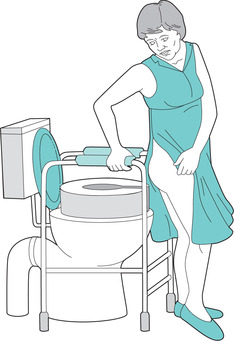Learning outcomes
By the end of this section, you should know how to:
▪ prepare the patient for this nursing practice
▪ collect and prepare the equipment
▪ provide facilities for the patient to empty his or her bladder or bowel, at home or in an institutional setting.
Background knowledge required
Revision of the anatomy and physiology of the urinary system, with special reference to micturition
Revision of the anatomy and physiology of the rectum and anus, with special reference to defaecation
Review of health authority policy regarding the disposal of excreta and the control of infection in both community and institutional care
Revision of continence management.
Indications and rationale for toileting
Toileting aims to provide the appropriate facilities for the patient to micturate or defecate. This may be a toilet, a commode, a bedpan or a urinal. A bedpan, urinal or commode should be provided for patients who are confined to bed or allowed up only for short periods. Assistance to the toilet should be provided for those who are too frail or immobile to be self-caring in relation to toileting.
 Equipment
Equipment1. Bedpan, urinal, commode or toilet, as appropriate
2. Toilet paper
3. Disposable cover for the bedpan or urinal
4. Gloves
5. Measuring jug
6. Bedpan disposer, e.g. Clinamatic
7. Bedpan washer for non-disposable equipment
8. Facilities for handwashing
9. Facilities for communicating the patient’s need for toileting to the nurse, e.g. a bell
10. Appropriate aids for moving and handling
11. Receptacle for soiled disposable items.
Bedpan
For female patients, a bedpan may be used for micturition and defaecation. For male patients, it may be used for defaecation, but a urinal should be offered at the same time for micturition. Toilet ware may be disposable or non-disposable; non-disposable equipment usually being made of plastic. Disposable equipment is, however, increasingly being used. A traditional or a slipper bedpan may be used, the latter having the advantage of being easier to insert and more comfortable to use.
This should be placed in a rigid bedpan holder and taken to the bedside under a disposable cover. The used bedpan should be flushed in the bedpan disposer according to the manufacturer’s instructions. The holder should be washed and dried before storage.
Plastic bedpan
This should be covered with a disposable cover and the used bedpan placed in the bedpan washer according to the manufacturer’s instructions. The bedpan should be washed and dried before storing, and regular sterilisation should be performed according to health authority policy. In the community, waste should be disposed of in the toilet and the equipment cleaned according to local infection control policy.
Urinal
This is used for male patients for micturition and should be covered with a disposable cover when taken to and from the patient. Like a bedpan, it may be disposable or non-disposable; after use, it is processed in the same way. A female urinal is available and may be suitable for some patients (Fader et al 1999).
Commode
This is a mobile chair constructed to hold a bedpan, which can be taken to the bedside for the patient’s use (FIGURE 41.1 and FIGURE 41.2). It may also be built to transport the patient to the toilet so that the commode seat fits over the toilet seat. Many mechanical lifting aids incorporate a commode seat so that the patient may be taken safely to the ward toilet or use it as a conventional commode (see the manufacturer’s instructions). A commode can be made available for patients at home to maintain their independence, or as a temporary help for toileting if access to the bathroom is difficult.
 |
| FIGURE 41.1Use of hand rails and a raised seat to promote independence athome |
 |
| FIGURE 41.2Adaptation of clothing for ease of access when toileting |
 Guidelines and rationale for this nursing practice
Guidelines and rationale for this nursing practiceGuidelines are given for the provision of a bedpan to a female patient and a urinal to a male patient.
The provision of a bedpan for a female patient
▪ explain this nursing practice to the patient to gain consent and co-operation, and encourage participation in care
▪ respond immediately to the patient’s request for a bedpan to prevent incontinence and patient distress
▪ don a plastic apron after washing thehands to prevent contamination (Jeanes 2005)
▪ don plastic gloves to prevent contamination from body fluids
▪ collect and prepare the bedpan, carrying it to the bedside under a disposable cover to maintain self-esteem and reduce embarrassment
Stay updated, free articles. Join our Telegram channel

Full access? Get Clinical Tree


Get Clinical Tree app for offline access
